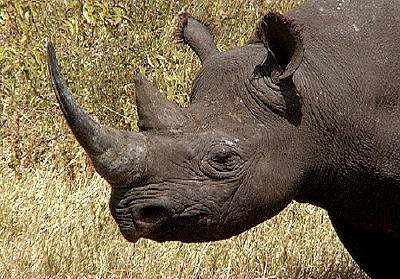





|
|
|
|
July 10, 2006
Fight ignorance before it's too late
When I started writing this post, I had intended it as a lead-in to this week's RINO Sightings Carnival, which is hosted by BloodSpite at Technography. It's a great carnival, artistically and poetically presented, and I highly recommend it. Lots of good rhino pictures, too, and the pictures served as a poignant reminder that the critter we like to emulate is in serious, serious trouble. I say that not as an environmentalist, because I'm not an environmentalist. However, I am someone who admires these grand animals and hates stupidity and ignorance. And I am very sorry to read that the West African black rhino has apparently become extinct, as a result of poaching: One of four sub-species of African black rhinoceros has been declared extinct after researchers failed to find the animal in its last known habitat.From 3000 to 10 is decimated? Wrong. Formally speaking, "decimated" means a ten percent reduction in numbers. The Black Rhinoceros subspecies had not been decimated, but nearly extirpated, and now it has been annihilated. A shame, but what is not entirely clear from the article is whether the primary culprit is the use of the horn as an aphrodisiac. It appears not, as the primary uses are as Yemeni daggers and in Chinese medicine: Africa's "black" and "white" rhinoceros total about 3,600 and 11,100 individuals, respectively. The Indian rhino numbers about 2,400. The Javanese and Sumatran rhinos are in truly dire condition. About 300 Sumatran rhinos survive in peninsular Malaysia, Sabah, and Indonesia (and perhaps a few in Thailand and Burma); only about 60 Javanese rhinos remain in the wild, including one group of 50 in Java and a second population of around 10 in Vietnam.According to the Honolulu Zoo, a fatwa was issued by Yemen's Grand Mufti saying it was "against the will of Islam to kill rhinos in for dagger handles" but I guess that was too little, too late. In any case, the Yemeni "Jambiya" dagger tradition is a local cultural one, not grounded in Islam. As to the rhino horn's use in Chinese medicine, it's grounded in rank superstition. The horns have been studied scientifically, and found to have no medicinal properties, and no aphrodisiac effects. Furthermore, the only places where the rhino horn has ever been used as an aphrodisiac were said to be in certain parts of India, and even that has died out. Thus, the report that it's "used as an aphrodisiac in Yemen and China" would seem to be incorrect. Medicine, yes. Dagger handle, yes. Aren't these ignorant customs superstitious and idiotic enough without having to blame sex too? I'm sorry that it's too late to save the West African Black Rhino, and that there isn't a damned thing I can do about it.  The whole thing is a crying shame. Sigh. While it won't save the real rhinos, as a means of combatting ignorance I don't see how reading this week's RINO Sightings Carnival can do any harm. American RINOs are a relatively new breed, and fortunately, they're far from extinct. posted by Eric on 07.10.06 at 03:24 PM |
|
March 2007
WORLD-WIDE CALENDAR
Search the Site
E-mail
Classics To Go
Archives
March 2007
February 2007 January 2007 December 2006 November 2006 October 2006 September 2006 August 2006 July 2006 June 2006 May 2006 April 2006 March 2006 February 2006 January 2006 December 2005 November 2005 October 2005 September 2005 August 2005 July 2005 June 2005 May 2005 April 2005 March 2005 February 2005 January 2005 December 2004 November 2004 October 2004 September 2004 August 2004 July 2004 June 2004 May 2004 April 2004 March 2004 February 2004 January 2004 December 2003 November 2003 October 2003 September 2003 August 2003 July 2003 June 2003 May 2003 May 2002 See more archives here Old (Blogspot) archives
Recent Entries
• War For Profit
• How trying to prevent genocide becomes genocide • I Have Not Yet Begun To Fight • Wind Boom • Isaiah Washington, victim • Hippie Shirts • A cunning exercise in liberation linguistics? • Sometimes unprincipled demagogues are better than principled activists • PETA agrees -- with me! • The high pitched squeal of small carbon footprints
Links
Site Credits
|
|